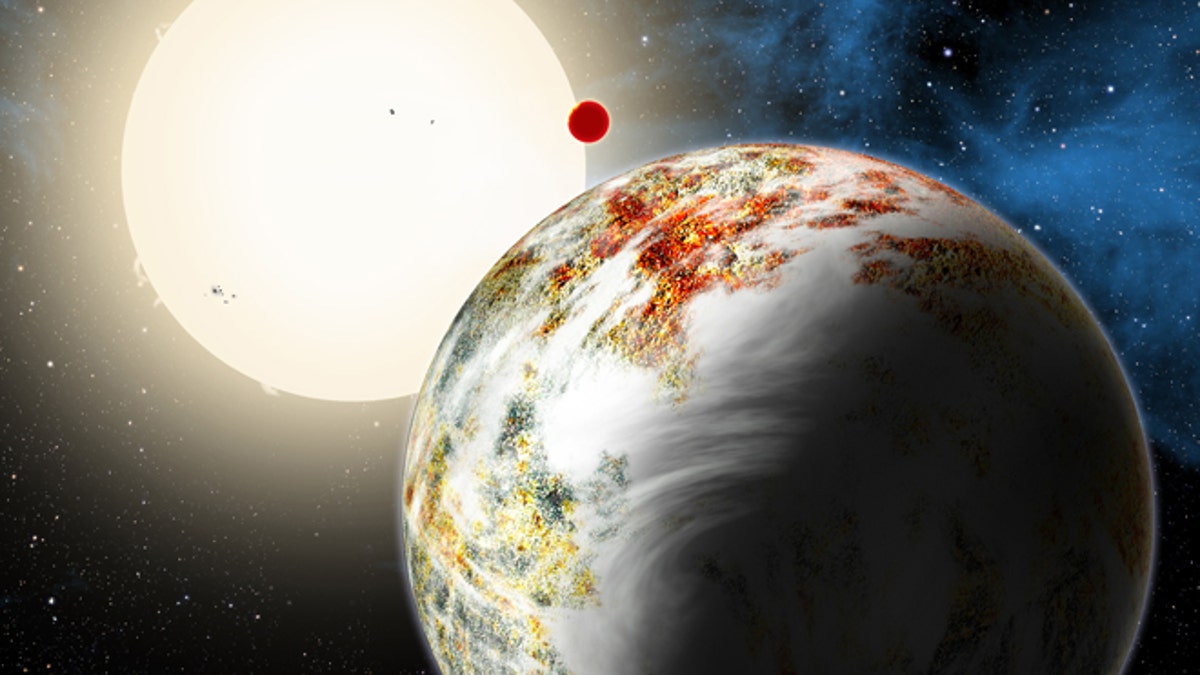
((Credit: David A. Aguilar, CfA))
Researchers have discovered what is being called the “Godzilla of Earths” some 560 light years from Earth, in the constellation Draco.
The planet, named Kepler-10c after the NASA Kepler space telescope that found it, is a rocky world with 17 times the mass of Earth. While other “Super-Earths” have been discovered by astronomers before, this one is so large that it has been dubbed a “Mega-Earth” and been compared to the giant monster of film fame.
“This is the Godzilla of Earths!” said Harvard-Smithsonian Center for Astrophysics researcher Dimitar Sasselov, according to Forbes. “But unlike the movie monster, Kepler-10c has positive implications for life.”
The weight and mass of Kepler-10c has shocked scientists as it throws into flux the current understanding of planet formation, which up until now theorized that massive planets attract massive amounts of hydrogen that transform the celestial bodies into gas giants like Jupiter and Saturn. Kepler 10-c suggests that these plump planets can maintain a rocky environment with well-defined edges without becoming bloated with gases.
The planet is also very, very old – formed about 11 billion years ago, less than 3 billion years after the birth of the universe – which dispels another long held astronomical theory that rocky worlds did not exist that long ago. This has led some scientists to believe that older planets that are closer to Earth may be able – or have been able – to sustain life.
“Finding Kepler-10c tells us that rocky planets could form much earlier than we thought. And if you can make rocks, you can make life,” Sasselov said.
The real estate market on Kepler-10c, however, may not be the best. It is too close to its parent star and its surface has been all but fried to a crisp. Gravity is also three times that of Earth – making any life that would exist on the planet very squat – and Kepler-10c is 2.3 times the diameter of Earth but is much denser, particularly toward the core.
“It’s still rock, but it’s rock that’s twice as dense as the rock we’re used to,” Sasselov added.
The discovery of Kepler-10c adds more credence to the theory that there is an abundant number of planets in the solar system – practically one for every star.
Despite the number of planets, scientists still have not found one that has a similar make-up to Earth or one that meets the tight parameters to support life.
Astrophysicist Ofer Cohen of the Harvard-Smithsonian Center for Astrophysics and his colleagues have identified three candidate planets found by the Kepler telescope as similar to Earth. These planets are rocky and orbiting their stars in what is called the “habitable zone” — the Goldilocks position that is not to close to a star as to burn everything up and not too far away that water would freeze on the surface.
The “habitable zones” of these planets are relatively close, given that they orbit common red dwarfs – our sun is a larger yellow dwarf – but the close proximity to the stars adds a number of factors into the equation that could create a no-go environment for life. Most importantly is the stellar wind, the particles streaming from the star’s surface, that would have stripped away the atmospheres of these planets.
“These planets don’t reside in a vacuum,” Cohen said, according to The Washington Post. “They reside in a medium that has a continuous flow of particles, mostly protons that are emitted by the star.”
Follow us on twitter.com/foxnewslatino
Like us at facebook.com/foxnewslatino
